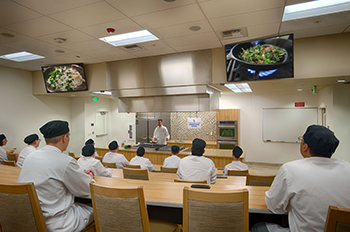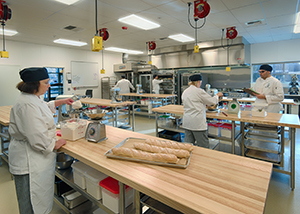American River College Expands Culinary Arts Program
 SACRAMENTO, Calif. — American River College in Sacramento wanted to expand the teaching facility for its Culinary Arts and Hospitality Management Program to help accommodate the 400 students enrolled and to build on its reputation as one of the most respected culinary arts programs in Northern California.
SACRAMENTO, Calif. — American River College in Sacramento wanted to expand the teaching facility for its Culinary Arts and Hospitality Management Program to help accommodate the 400 students enrolled and to build on its reputation as one of the most respected culinary arts programs in Northern California.
Locally based DLR Group designed a 13,600-square-foot addition and 6,000-square-foot modernization, tripling the size of both the culinary classroom space and on-site Oak Café. School Construction News spoke with DLR Group Designer Chris Brown about the project and what it means for American River College students.
Q: What was the project’s primary goal?
Brown: The existing teaching facility was small and inadequate, restricting student enrollment and creating a wait list for classes. It also included The Oak Café, a four-star fine-dining establishment serviced by culinary students and only open for lunch, which had a bakery display case by the entrance. The café was turning away as many as 200 diners a month and the bakery was selling out every day. Storage also was an issue; catering equipment was stored in Tuff Sheds and shipping containers.
This 13,600-square-foot addition and 6,000-square-foot modernization triples the size of both the academic components of the program and the dining capacity for The Oak Café. The expanded Oak Café and addition of the retail bakery improves the dining experience for visitors and strengthens the school’s commitment of service to the community. The design creates an environment that fosters authentic, real-world learning experiences and enriches the lives of the student body and the community. It promotes student-instructor-community interaction and collaboration, reinforcing the value that future leaders of the restaurant industry bring to our community.
Q: How will the new addition and modernization enhance the student experience?
 Brown: Students in this program are already in high demand in the local workforce, and this project will only enhance their culinary experience. Efficient layout of spaces, which includes state-of-the-art equipment recommended and used in the industry, provides students with more real-world education and training. The Culinary Arts and Hospitality Management program is self-sustaining through revenue generated by the café, bakery and catering businesses, eliminating the need for students to pay any additional lab fees. Interconnected lab spaces and transparency into the labs allows students and visitors to observe the action, which encourages collaboration in the learning process.
Brown: Students in this program are already in high demand in the local workforce, and this project will only enhance their culinary experience. Efficient layout of spaces, which includes state-of-the-art equipment recommended and used in the industry, provides students with more real-world education and training. The Culinary Arts and Hospitality Management program is self-sustaining through revenue generated by the café, bakery and catering businesses, eliminating the need for students to pay any additional lab fees. Interconnected lab spaces and transparency into the labs allows students and visitors to observe the action, which encourages collaboration in the learning process.
Q: What are some of the project’s key design elements?
Brown: Oak Tree Design Concept — With the four-star Oak Café previously in an obscure location behind an existing building, this concept creates a clear entry statement and destination point for visitors. The entry and lobby design, inspired by an oak tree, takes the abstract form of a tree trunk that branches out into the other areas of the building. The floor and walls reflect growth rings of an oak tree.
Programmatic Efficiency — The floor plan maximizes academic programs and fosters interactive learning. The main kitchen in the middle of the building increases functionality and gives direct access to the café dining room, four kitchen labs and a joint-use ware washing and storage area. Learning and public spaces are connected, encouraging interaction between the public and students.
Campus Gateway — Located prominently on campus, the new building is the main gateway onto campus. It is a beacon to the community and unifies the culinary building and the fine arts complex. The exterior reflects a similar palette of color, materials, scale and mass as the surrounding buildings, and gives a strong identity to the campus while blending harmoniously into the context.
Q: How was new technology integrated in the facility?
Brown: The high-tech spaces for instructor-student interaction resemble the real-world working conditions of the industry, with state-of-the-art equipment recommended by community partners. Video equipment in the demonstration kitchen allows students and visitors to observe the action up close on screen.
Q: How is this project different from those you’ve completed in the past?
Brown: The amount of community involvement, including donors and alums, was extensive. They played a key role in promoting the program through fundraisers such as Forks and Corks. The idea of creating a place that produces top local chefs and bakers is very satisfying, especially when you can go to the Oak Café and sample their cuisine.
